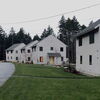Processing Your Payment
Please do not leave this page until complete. This can take a few moments.
- News
-
Editions
View Digital Editions
Biweekly Issues
- December 1, 2025
- Nov. 17, 2025
- November 03, 2025
- October 20, 2025
- October 6, 2025
- September 22, 2025
- + More
Special Editions
- Lists
- Viewpoints
-
Our Events
Event Info
Award Honorees
- Calendar
- Biz Marketplace
Some sectors show promise as construction rebounds from the recession
National recessions tend to affect New England later and with less severity than the rest of the country. It also takes New Englanders longer to pull themselves out of recession. This is where an industry vital to our state —construction — finds itself right now.
More than 90% of construction companies are small businesses with fewer than 20 employees, representing a vital part of the Maine economy. Things aren't as bleak as they were a couple years ago, but the industry hasn't dug itself out of the hole enough to be completely confident about the future. There are, however, bright spots and promising indicators in different sectors of the construction industry.
Infrastructure
Public construction of roads, bridges and the like has kept construction laborers and many companies near capacity for the past couple of years and, with the anemic winter we experienced, there's an early uptick in construction work in many municipalities. Although the level of funding may not be what the industry or the country ultimately needs to have a first-rate transportation and infrastructure system, public-sector construction will keep laborers busy in 2012.
Multi-family housing
Housing authority projects, senior assisted-living and other private multi-family housing starts have increased as new, single-family housing has declined. For example, the U.S. Department of Housing and Urban Development awarded Maine $5 million in February for large-scale improvements to public housing units. Expect this trend to continue until the inventory of single-family residential homes on the market decreases to more manageable levels.
Health care
Maine has one of the oldest populations in the country, a population that's going to need more health care services. The MaineGeneral Health project is the largest construction project in Maine's history at a reported $322 million, promising 350 construction jobs. We're likely to see more renovations, additions, satellite and new health care facilities in Maine.
Colleges and universities
College and university construction has been somewhat immune from the recession. For instance, Colby College is building a 26,000-square-foot addition to its art museum that will make it the largest museum in Maine. Bates, Bowdoin and the University of New England will undoubtedly continue to increase their footprints.
Green construction
Green construction is off to a slow start because of the length of the recession, but sustainability concepts are here to stay. Many contractors now have LEED-accredited professionals on staff because customers are asking sustainability questions as part of the design and construction process.
Wind power
Although this is a topic with two very passionate sides, the fact is that wind power construction has provided a significant amount of revenue over the past couple of years and that's likely to continue. There are about 20 projects under development, in construction or up and running, starting with Mars Hill in 2007. This doesn't include smaller-scale wind projects across the state.
Regionalization
The extended downturn in construction work in all New England states caused contractors to try to regionalize in order to maintain their annual levels of work. Southern Maine has never seen such an influx of contractors from Massachusetts, New Hampshire and Vermont. Companies have opened satellite offices in other states where there are more promising levels of sustained construction work. Since the lien laws, prompt payment laws and licensing statutes are different in the various New England states, this regionalization bears watching.
Residential
There are upticks in residential construction in some regions of the country, but new residential construction starts in Maine are still poor. Many people who were in residential construction have exited the sector, and the work doesn't appear to be increasing significantly anytime soon. Residential contractors that remain, however, are more likely to be better capitalized and able to turn out first-rate quality construction, as are the material suppliers and specialty subcontractors. These are the folks who made good business decisions about how to cope with the downturn and they're more likely to be poised to take advantage of future opportunities.
Long-term economic forecasts for both residential and commercial construction are actually bullish, and people in the industry, including this author, are optimistic about its long-term prospects.
Mainebiz web partners

The Giving Guide
The Giving Guide helps nonprofits have the opportunity to showcase and differentiate their organizations so that businesses better understand how they can contribute to a nonprofit’s mission and work.
Learn More
Work for ME
Work for ME is a workforce development tool to help Maine’s employers target Maine’s emerging workforce. Work for ME highlights each industry, its impact on Maine’s economy, the jobs available to entry-level workers, the training and education needed to get a career started.
Learn More
Groundbreaking Maine
Whether you’re a developer, financer, architect, or industry enthusiast, Groundbreaking Maine is crafted to be your go-to source for valuable insights in Maine’s real estate and construction community.
Learn more-
The Giving Guide
The Giving Guide helps nonprofits have the opportunity to showcase and differentiate their organizations so that businesses better understand how they can contribute to a nonprofit’s mission and work.
-
Work for ME
Work for ME is a workforce development tool to help Maine’s employers target Maine’s emerging workforce. Work for ME highlights each industry, its impact on Maine’s economy, the jobs available to entry-level workers, the training and education needed to get a career started.
-
Groundbreaking Maine
Whether you’re a developer, financer, architect, or industry enthusiast, Groundbreaking Maine is crafted to be your go-to source for valuable insights in Maine’s real estate and construction community.
ABOUT
NEW ENGLAND BUSINESS MEDIA SITES
No articles left
Get access now
In order to use this feature, we need some information from you. You can also login or register for a free account.
By clicking submit you are agreeing to our cookie usage and Privacy Policy
Already have an account? Login
Already have an account? Login
Want to create an account? Register
Get access now
In order to use this feature, we need some information from you. You can also login or register for a free account.
By clicking submit you are agreeing to our cookie usage and Privacy Policy
Already have an account? Login
Already have an account? Login
Want to create an account? Register







Comments